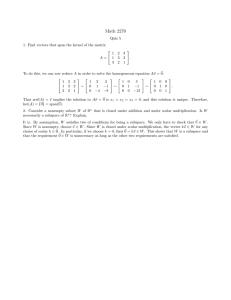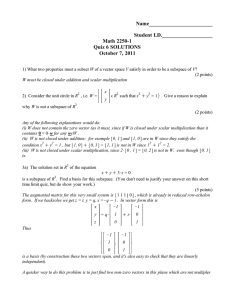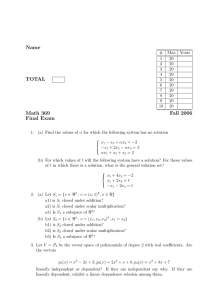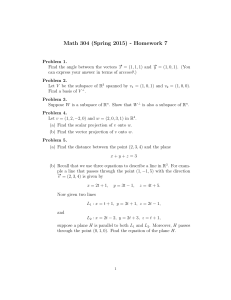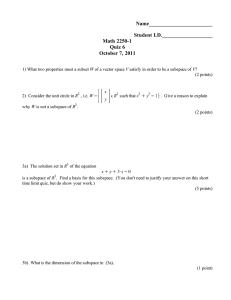Math 215 Exam #1 Solutions
advertisement
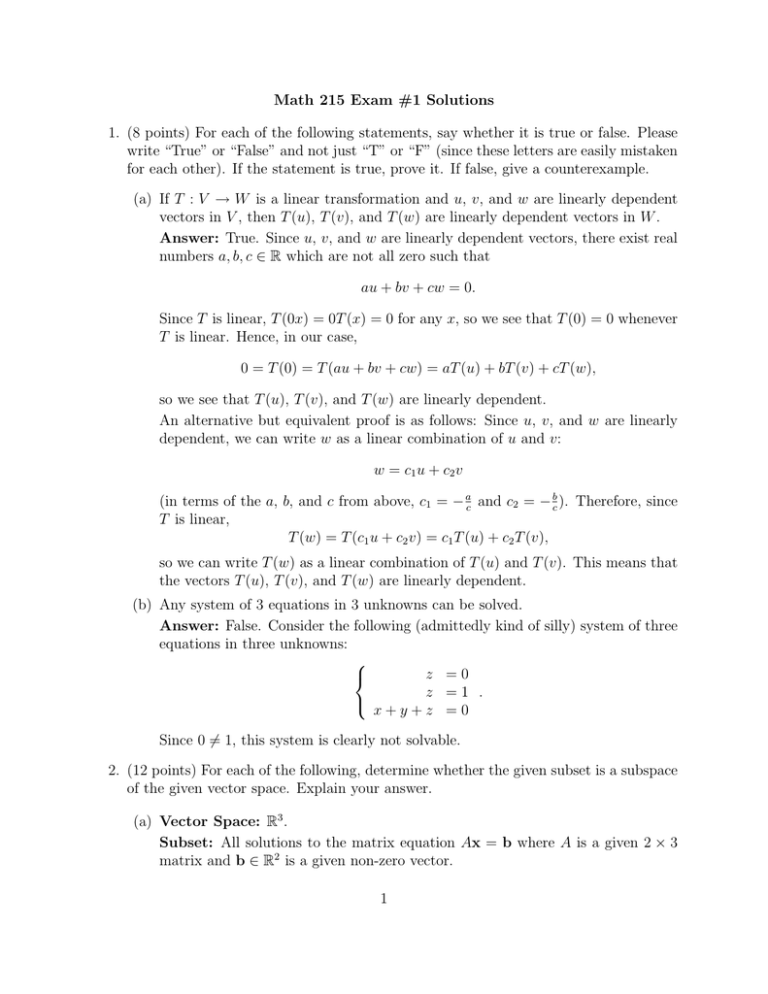
Math 215 Exam #1 Solutions 1. (8 points) For each of the following statements, say whether it is true or false. Please write “True” or “False” and not just “T” or “F” (since these letters are easily mistaken for each other). If the statement is true, prove it. If false, give a counterexample. (a) If T : V → W is a linear transformation and u, v, and w are linearly dependent vectors in V , then T (u), T (v), and T (w) are linearly dependent vectors in W . Answer: True. Since u, v, and w are linearly dependent vectors, there exist real numbers a, b, c ∈ R which are not all zero such that au + bv + cw = 0. Since T is linear, T (0x) = 0T (x) = 0 for any x, so we see that T (0) = 0 whenever T is linear. Hence, in our case, 0 = T (0) = T (au + bv + cw) = aT (u) + bT (v) + cT (w), so we see that T (u), T (v), and T (w) are linearly dependent. An alternative but equivalent proof is as follows: Since u, v, and w are linearly dependent, we can write w as a linear combination of u and v: w = c1 u + c2 v (in terms of the a, b, and c from above, c1 = − ac and c2 = − cb ). Therefore, since T is linear, T (w) = T (c1 u + c2 v) = c1 T (u) + c2 T (v), so we can write T (w) as a linear combination of T (u) and T (v). This means that the vectors T (u), T (v), and T (w) are linearly dependent. (b) Any system of 3 equations in 3 unknowns can be solved. Answer: False. Consider the following (admittedly kind of silly) system of three equations in three unknowns: z =0 z =1 . x+y+z =0 Since 0 6= 1, this system is clearly not solvable. 2. (12 points) For each of the following, determine whether the given subset is a subspace of the given vector space. Explain your answer. (a) Vector Space: R3 . Subset: All solutions to the matrix equation Ax = b where A is a given 2 × 3 matrix and b ∈ R2 is a given non-zero vector. 1 Answer: No, this is not a subspace. If x1 and x2 are two solutions to the equation, then Ax1 = b and Ax2 = b. However, A(x1 + x2 ) = Ax1 + Ax2 = b + b = 2b. Since b is not the zero vector, b 6= 2b, so we see that x1 + x2 is not a solution to the equation. Thus, the given subset is not closed under addition and so cannot be a subspace. Alternatively, we could show that the given subset is not closed under scalar multiplication. If x1 is a solution to the equation (meaning that Ax1 = b), we have that A(0x1 ) = A(0) = 0 6= b so 0x1 is not in the subset. Hence, the subset is not closed under scalar multiplication. (b) Vector Space: All 2 × 2 matrices. Subset: The matrices a b c d such that ad − bc = 1. Answer: This is not a subspace. The two matrices 1 0 −1 0 and 0 1 0 −1 are in this set, but 1 0 0 1 + −1 0 0 −1 = 0 0 0 0 is not, so the set is not closed under addition and hence cannot be a subspace. 1 0 Alternatively, although is in the subset, 0 1 1 0 0 0 0 = , 0 1 0 0 which is not in the subset, so the subset is not closed under scalar multiplication and so cannot be a subspace. (c) Vector Space: All real-valued functions. Subset: The solutions y = y(t) of the differential equation y 00 − 6y 0 + 7y = 0. Answer: This is a subspace. If y1 and y2 are solutions to the differential equation, then (y1 + y2 )00 − 6(y1 + y2 )0 + 7(y1 + y2 ) = (y100 − 6y10 + 7y1 ) + (y200 − 6y20 + 7y2 ) = 0 + 0 = 0, 2 so y1 + y2 is also a solution. Thus, the set of solutions is closed under addition. To see that it is also closed under scalar multiplication, let c ∈ R. Then (cy1 )00 − 6(cy1 )0 + 7(cy1 ) = c(y100 − 6y10 + 7y1 ) = c(0) = 0, so cy1 is a solution. Since the set is closed under both addition and scalar multiplication, it is a subspace. 3. (8 points) The equation x + 2y + z = 0 describes a plane P in R3 . Is P a subspace of R3 ? If so, find a basis for P . If not, find an equation which determines a plane parallel to P which is a subspace of R3 . Answer: Yes, P is a subspace. To confirm this,checkthat it is closed under addition x1 x2 and scalar multiplication. Suppose y1 and y2 are in P . That means that z1 z2 x1 + 2y1 + z1 = 0 x2 + 2y2 + z2 = 0. Now, x1 x2 x1 + x2 y1 + y2 = y1 + y2 z1 z2 z1 + z2 is also in P because (x1 + x2 ) + 2(y1 + y2 ) + (z1 + z2 ) = (x1 + 2y1 + z1 ) + (x2 + 2y2 + z2 ) = 0 + 0 = 0. Hence, P is closed under addition. Also, if c ∈ R, then x1 cx1 c y1 = cy1 z1 cz1 is in P because (cx1 ) + 2(cy1 ) + (cz1 ) = c(x1 + 2y1 + z1 ) = c(0) = 0, and so P is closed under scalar multiplication. Therefore, P is indeed a subspace. Alternatively, recall that we usually interpret systems of m equations in n variables in terms of matrix equation involving an m × n matrix. In this case, the “system” consists of one equation in 3 variables, so the corresponding matrix equation is x 1 2 1 y = [0]. z 3 Clearly, the vectors in P are precisely the vectors in the nullspace of the 1 × 3 matrix [1 2 1]. Since we know the nullspace of a matrix is a subspace, this implies that P is a subspace. This nullspace interpretation of P makes it easy to find a basis for P ; just use the same procedure we always use to find a basis for the nullspace. We have that x = −2y − z, so the solutions of the above matrix equation are −2y − z −2 −1 = y 1 + z 0 . y z 0 1 −2 −1 Thus, the vectors 1 and 0 give a basis for the nullspace of [1 2 1], which 0 1 is just P . 4. (8 points) Consider the system of equations x1 + 3x2 + 2x3 + x4 = −5 − x2 + x3 = −2 −x1 − 2x2 − 3x3 − x4 = 7 In parts (a) and (b), you may use the fact that 1 0 5 1 1 1 3 2 1 −5 0 −1 1 0 −2 row reduces to 0 1 −1 0 2 0 0 0 0 0 −1 −2 −3 −1 7 (a) Find all solutions to this system of equations. Answer: Since the augmented matrix corresponding to the system row-reduces to 1 0 5 1 1 0 1 −1 0 2 , 0 0 0 0 0 which is in reduced-echelon form, the given system is equivalent to the system x1 + 5x3 + x4 = 1 x2 − x3 = 2 0 = 0 or, equivalently, x1 = 1 − 5x3 − x4 . x2 = 2 + x3 4 Thus, all solutions are of the form 1 2 + x3 0 0 −5 1 + x4 1 0 −1 0 . 0 1 (b) Each of the three equations in the system describes a hyperplane in R4 ; do these three hyperplanes intersect? If so, do they intersect in a point, a line, a plane, or a hyperplane? Answer: Yes, the hyperplanes intersect; their intersection is precisely the set of solutions to the system of equations. The intersection is a plane since there are two free variables. 5
